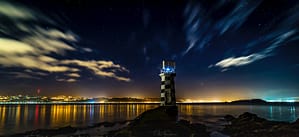Wellington Cable Car and the Kelbrun Lookout
Wellington’s antique cable car has been chugging up the hill to the Kelburn Lookout, next door to the Botanic Gardens, since 1912. This quaint journey is a scenic (and much more relaxed) alternative to puffing your way up Wellington’s steep hill from Lambton Quay in the waterfront central district. There are excellent views across the city along the way, and keen photographers will definitely want to get snap-happy with the cityscape panoramas laid out before them once at Kelburn Lookout. The Kelburn cable car terminal also has a small museum, which displays the original cable car used on the tracks.
The Beehive
Wellington’s most iconic building is The Beehive – site of New Zealand’s parliament. Designed by British architect Sir Basil Spence and built between 1964 and 1979, the building with its distinctive shape is the city’s most love-it-or-hate-it piece of architecture. Next door is the more classical building of Parliament House, built in 1907 in Neoclassical Edwardian style and home to The Chamber where parliamentary debates are held. Free one-hour tours of the parliament buildings are held daily between 10 am and 4 pm and trace New Zealand’s parliamentary history as well as touring through the important government rooms. They leave from the visitor center on the ground floor of The Beehive. The parliament gardens around the buildings are open to the public and contain rose gardens and a statue of Richard John Seddon who was prime minister of New Zealand between 1893 and 1906.
Zealandia
Dedicated to exhibiting New Zealand’s conservation efforts and its unique nature and wildlife, Zealandia is a 225-hectare urban eco-sanctuary only two kilometers from the central city. Here, many of the country’s native birds, including endangered species such as the stitchbird, saddleback, and takahe can be heard and seen as well as more than 100 kiwi (which can be spotted on guided night tours) and New Zealand’s famed reptile, the tuatara. There are 32 kilometers of walking trails throughout the reserve for visitors to explore plus a museum that documents the natural history of the country.
City Gallery Wellington
Housed in the historic building of the old city library, City Gallery Wellington is one of the leading contemporary art spaces in New Zealand with a changing program of temporary exhibitions throughout the year displaying artworks by both renowned and up-and-coming local, Pacific Island, and international artists. Devoted to modern visual arts, exhibitions range from painting to photography to sculpture, multimedia work, and art installations. The gallery is also one of Wellington’s main cultural hubs with a series of talks, meet-the-artist events, and live performances taking place throughout the year.
Princess Bay
Nine kilometers south of the central city, in the Houghton Bay district, is the sandy cove of Princess Bay. This sheltered sweep of sand with plenty of rock pools is a favorite swimming and picnicking spot for locals during weekends in the summer months. On a clear day, the beach affords excellent views that can stretch across to the South Island. A short coastal track above the beach runs to a lookout point with even better views and is popular strolling territory in the late afternoon.
Matiu Island
For nature lovers looking for a secluded getaway close to the city, Matiu Island (also known as Somes Island) in Wellington Harbour offers up a heady dose of wild New Zealand landscapes. During the pre-European era, Matiu Island was occupied by Maori. During the modern era, it was used as a quarantine station, internment camp, and military installation until being turned over to New Zealand’s Department of Conservation as a nature reserve. For both day-trippers and overnighters, the island has a series of short hiking trails up to its highest point, with World War II gun emplacements, and around the its perimeter, all with excellent views across to the mainland. Regular daily ferries depart from Queens Wharf to the island, and a campsite accommodates overnighters.
Wellington Zoo
Wellington Zoo is the oldest zoo in New Zealand, established in 1906, and is well known for its conservation efforts. If you have little ones in tow, this is an excellent place to see some of New Zealand’s wildlife up close, especially shy animals such as the kiwi bird (the country’s national emblem) and the tuatara reptile. There are also plenty of well-maintained enclosures for animals from across the world including the Malayan sun bear and the giraffe, monkey, chimpanzee, meerkat, and big cats. The zoo’s animal hospital, known as The Nest, can be visited to see the work of the zoo’s veterinarian staff.
Mount Victoria
Immediately east of the city center is Mount Victoria (196 meters high) that offers fantastic views over the cityscape, although it can be extremely windy on top. A narrow winding road, signposted “Lookout,” runs up from Oriental Bay to the Byrd Memorial below the viewing platform. From the terrace on the summit there is a magnificent panorama of the broad city, the harbor, and Cook Strait in one direction and Kelburn Park with the university buildings in the other. The Byrd Memorial commemorates the American aviator, Richard Byrd, who in 1929 made the first flight over the South Pole from his base in New Zealand
Wellington Waterfront
Wellington’s waterfront area is an attractive district right in the hub of the central city. Both Queen’s Wharf and Frank Kitts Park are surrounded by fine buildings, including the Civic Centre and the Museum of New Zealand. From Frank Kitts Park, there is a good view of Wellington Harbour, and the park hosts a market every Saturday. There are plenty of cafés and restaurants in this area, so it’s a great place for a pit stop while strolling the central city.

